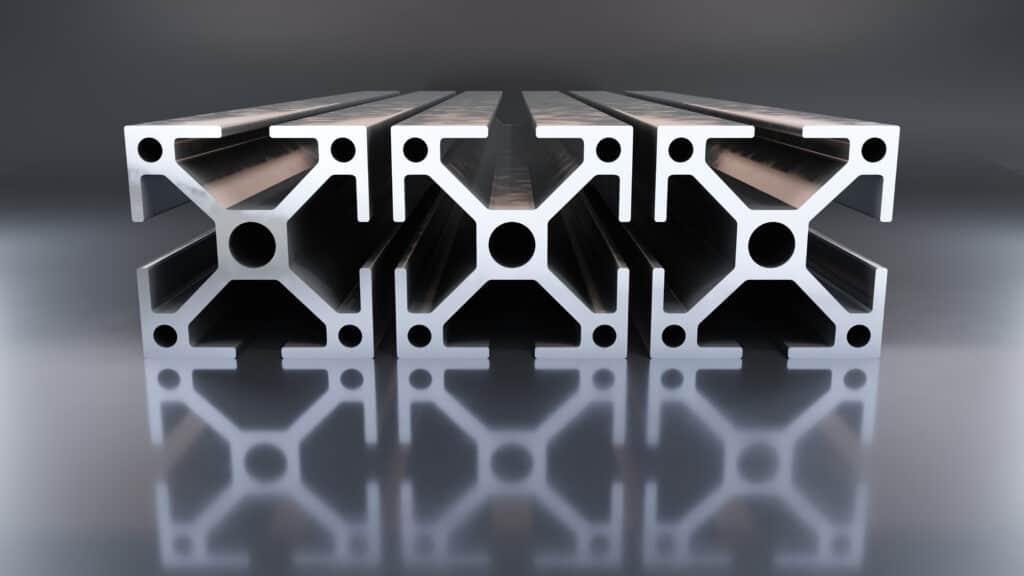How Has Aluminum Extrusion Evolved Over Time?

Aluminum Extrusion’s Evolution Since the Late 1700s
Aluminum extrusion converts aluminum alloys into cross-sections for various applications. The extrusion process takes advantage of aluminum’s unique properties, such as malleability and strength. Aluminum only has a third of the density of steel, yet offers considerable strength. These characteristics make aluminum alloys easy to cast, machine, and form into customizable shapes.
A block of aluminum, known as a billet, is forced through an opening in a die, which creates a continuous cross-sectional profile. The resulting aluminum extrusion is pliable, long, and adaptive to applications in architecture, automotive, lighting, and more.
Here we’ll discuss the history of aluminum extrusions, typical applications, and some tips when selecting an aluminum extruder.
History of Aluminum Extrusion
Inventor and locksmith Joseph Bramah first designed and patented a metal extrusion process in 1797. With blacksmith Henry Maudslay, Bramah originally aimed to produce an impregnable lock but soon realized he could produce other parts like pipes using the method, which involved manually driving a soft metal through a mold.
In 1820, Thomas Burr began using a hydraulic press invented by Bramah to extrude lead rods and pipes. It wasn’t until 1886 that Charles Martin Hall and Paul Heroult independently developed an electrolysis smelting process that made aluminum easier to extract. As a result, it became much cheaper and easier to extract and extrude aluminum.
Alexander Dick invented the hot extrusion process in 1894, enabling manufacturers to extrude non-ferrous metals. Shortly after, in 1904, the first extrusion press was built. The aerospace and automotive industries were among the first to benefit from the extruded aluminum cross-sections this machine created.
Today, the aluminum extrusion market is worth over $87 billion and serves the aerospace, transportation, architecture, electrical, and many more industries.
Typical Use Cases for Extruded Aluminum
Below are some areas of extruded aluminum applications:
- Construction/Architecture: Extruded aluminum can be used for lighting fixtures, window and door frames, elevator shafts, bleachers, railings, balustrades, and other decorative and functional architectural components. Durable, lightweight aluminum segments are perfect for canopies when the framework cannot weigh much but needs to support a load. Its rust- and corrosion-resistant surface makes it ideal for building facades and interior accents.
- Automotive/Transportation: Panels, engine components, transmission housings, roof rails, radiator enclosures, drive shafts, cylinder liners, chassis, and bodies of automobiles can all be made with aluminum extrusions. They can also make truck and boat chassis components.
- Displays: Most stands used in exhibits and trade fairs are constructed using extruded aluminum alloys. They often feature interlocking properties for easy assembly. Different finishing treatments are available to enhance the appearance of the display. Other display applications for aluminum extrusions include point-of-sale (POS) displays and display cabinets.
- Electrical/Electronics: Because of its excellent conduction properties, extruded aluminum is used for busbars and other electronic devices, including LED light fittings and audio/visual systems. It is also found in the support structures for photovoltaic solar panels, which must be strong, corrosion-resistant, and lightweight.
Tips When Choosing an Aluminum Extrusion Manufacturer
To choose a reliable aluminum extruding company, make sure they have ISO certifications, produce high-quality results, implement quality control, deliver fast lead times, and operate with the utmost transparency.
Source International specializes in factory sourcing and management, and we can help you find the perfect aluminum extrusion company for your needs. As your supply management partner, we audit our factory partners and handle timezone, language, and cultural differences on your behalf so that you receive the highest quality extruded products on time.
Connect with our team today to learn more about our sourcing capabilities for aluminum extruders.


Comments are closed